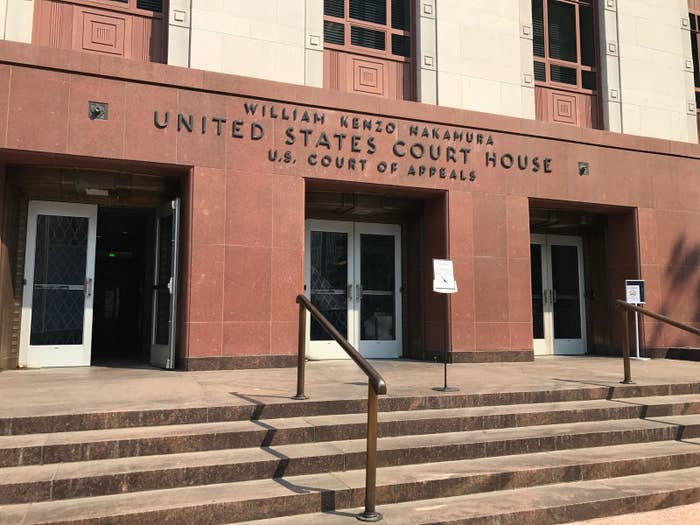
Federal appeals judges appeared to be skeptical of Trump administration attempts to broadly interpret who is covered by President Trump’s travel ban during oral arguments on the topic Monday.
The arguments at the US Court of Appeals for the Ninth Circuit in Seattle on Monday focused on the current partial application of the travel and refugee bans since late June — a move the US Supreme Court allowed in a June 26 order.
Ultimately, the Supreme Court will hear arguments this fall over the travel and refugee bans, but the arguments at the Ninth Circuit are important because they are one of the last times before then that the government will get to make its case about how it believes Trump’s ban should be seen by courts. Moreover, a ruling from the 9th Circuit could shift the way the justices approach the Supreme Court case, scheduled for arguments on Oct. 10.
Moments after the Justice Department lawyer defending the government’s argument began on Monday, Judge Ronald Gould cut in with a question.
“How can the government say” a grandparent or aunt or uncle isn’t a close family member, Gould asked. “In what universe does that come from?”
In the June order, the Supreme Court barred enforcement of the 90-day travel ban from six Muslim-majority countries or the 120-day halt to the US refugee program against those with a “credible claim of a bona fide relationship” to a US person or entity.
Since then, the fight has, unsurprisingly, focused on what constitutes a “credible claim of a bona fide relationship.”
The administration announced its policy for interpreting that language hours before it was due to to go into effect. The arguments in the seventh-floor courtroom on Monday dealt with two main points of contention around that language.
First, the government excluded “siblings-in-law, cousins, nieces, nephews, aunts, uncles, grandparents, and grandchildren” from the definition of those “close familial relationships” that would be exempted from the ban. The government also excluded refugees who have an “assurance” from a resettlement agency, rather than a scheduled relocation plan.
US District Judge Derrick Watson, however, barred the government from enforcing the ban against either of those groups.
The Justice Department subsequently asked the US Supreme Court to clarify its June order or take an appeal of Watson’s order and reverse that injunction. The court denied those requests, but it did put the resettlement agency part of the injunction on hold pending the outcome of the Justice Department’s appeal to the Ninth Circuit — a move that allows the federal government to keep out refugees for now who only have assurances from resettlement agencies and no other US connections.
Monday’s arguments in Seattle, then, were over those two provisions of the district court’s modified injunction.

The three judges hearing the case previously upheld most of the original district court injunction that put the bans on hold — a sign of their dissatisfaction with the executive order’s legality. A difference on Monday: The US Supreme Court partially reversed the 9th Circuit’s ruling, in effect, with its June order earlier this summer.
Hashim Mooppan, the Justice Department lawyer defending the government’s interpretation of that Supreme Court order, faced intense questioning from the three-judge panel hearing the case — particularly regarding the government’s exclusion of many people commonly thought of as close family members from the definition of “close familial relationship.”
“Could you explain to me what’s significantly different between a grandparent and a mother-in-law?” Judge Richard Paez asked via video conferencing. The question was a reference the Supreme Court’s order specifically stated that the mother-in-law of the plaintiff who joined in Hawaii’s lawsuit “clearly” has a close familial relationship with him. “One is in and one is out.”
Mooppan argued that the marriage “form[s] a spousal unit,” such that “[y]our spouse’s family becomes one family.” As such, he argued, there’s effectively no difference — in terms of deciding how close of a family member a person is — between a parent and a parent-in-law.
When pressed on the point that grandparents and grandchildren often have as big of a role in a family as in-laws, Mooppan pressed back. “Often extended family plays an important role,” but that doesn’t make it close family, he said.
The judges did not sound convinced. As Paez put it during Mooppan’s rebuttal arguments, if the Supreme Court wanted to limit those exempted from the ban to “immediate” family members, they would have done so.
On the other side was the lawyer for Hawaii, which sued the federal government over the executive order. Colleen Roh Sinzdak, the Hogan Lovells lawyer representing Hawaii, faced her toughest questions over whether refugee resettlement “assurances” should be seen as sufficient.
Mooppan had argued several points against exempting those with such assurances from the refugee ban. He argued, first, that the Supreme Court’s stay of the resettlement part of Watson’s order virtually resolved the question — because the standard for granting a stay means the Supreme Court considered whether the Justice Department is likely to succeed on its argument.
He argued further to allow refugees to come in with only “assurances” from a resettlement agency would render the Supreme Court’s June order “meaningless” — because it would allow almost all of those refugees who would have been able to come to the US during the time the 120-day ban is in effect to continue to come into the US in spite of the ban.
Sinzdak did not respond to that argument on Monday, but Hawaii’s lawyers had been dismissive of that argument in its court filing. “At bottom,” they wrote, “the Government’s complaint is that the District Court’s order will undermine its efforts to admit as few refugees as possible, but that policy argument is no basis for distorting the Supreme Court’s opinion to say what it does not.”
The Justice Department’s underlying argument, though, is that the resettlement agencies have a relationship with the federal government and not with the would-be refugees — which it argues means that the would-be refugees don’t actually have a relationship with a US entity.
Sinzdak countered that the Justice Department was arguing its case based on “new standards, not from the Supreme Court, but of the government’s own invention.”
Looking to the Supreme Court’s June order, she noted the court’s ruling exempted those whose relationships with US entities are “formal, documented and formed in the ordinary course.” This, she argued, meant they are “relationships that are formed in good faith, not to evade the executive order.” The resettlement agency “assurances” fit that definition, so they should be exempted from the ban.
The judges picked up on one point of the “invented” standards argument, getting into an extended back-and-forth with Mooppan over the question of whether it’s relevant whether the connection be “direct” or not.
“Where does it say a ‘direct’ relationship” is required in the Supreme Court’s order? Paez asked.
When Mooppan began to stumble a bit through an answer, Hawkins jumped in.
“So, nowhere,” the judge snapped from the bench.
Mooppan, though, attempted to press his point, arguing that it’s not just that it’s an indirect relationship between the resettlement agencies and the would-be refugees: “It’s nonexistent.”
Paez and Hawkins weren’t buying it, continuing to question Mooppan’s arguments on the point until he sat down to allow Sinzdak to argue.
During Sinzdak’s arguments, however, Judge Michael Daly Hawkins focused on a different issue altogether. Perhaps looking for a reason to explain the Supreme Court’s different treatment of the family portion and resettlement agency portion of Watson’s injunction modification, Hawkins asked about the distinction between the discretion involved in immigration law versus the refugee program.
Calling it “a basic difference,” he highlighted statutory rights relating to family-based immigration — which would require congressional action to change — and the largely “permissive” refugee program. Hawkins asked Sinzdak whether that distinction was important.
Although she initially pressed back somewhat on whether the president could totally halt the refugee program without congressional action, Sinzdak ultimately pointed to the Supreme Court’s June order to counter any view that the two sections should be seen differently. “The Supreme Court did not dwell on differences between immigrant and refugees,” she said. “They looked at who will experience concrete hardship.”
The court gave no signal as to its timeline for issuing a decision on the issues.
The arguments Monday were just the latest in the seven months of litigation since Trump first signed a travel ban executive order on Jan. 27.
After the Ninth Circuit declined to put a Seattle federal district court judge’s injunction against that first executive order on hold, the administration narrowed the ban slightly, with Trump signing a revised version — that he later called a “watered-down” version — on March 6.
Before that version could go into effect, however, Watson put the main parts of the ban on hold. A federal judge in Maryland also issued an injunction, albeit a narrower one, of that second version of the ban. The administration appealed both injunctions, and both courts upheld the injunctions in large part — banning the administration from enforcing either the travel or refugee bans or the 50,000-refugee cap.
Those rulings led to the Supreme Court appeal, which led to the partial stays of the district court injunctions. The Supreme Court also agreed to hear the case itself — the Oct. 10 arguments over whether the travel or refugee bans violate laws or the Constitution.

